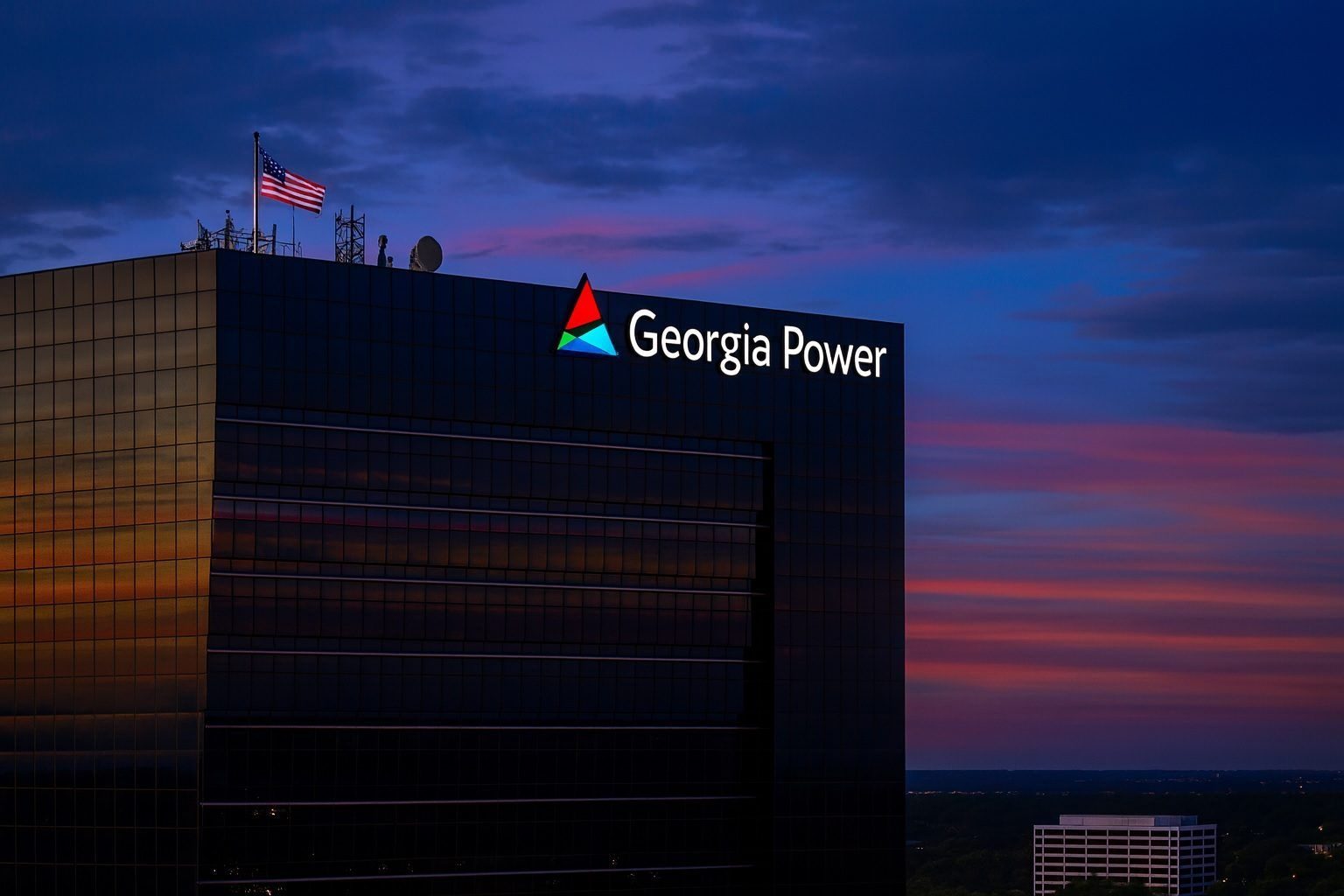ATLANTA — November 25, 2025
Georgia’s quiet power grid fight just turned into a kitchen‑table issue.
In the space of a few days, staff for the Georgia Public Service Commission (PSC) have warned that Georgia Power’s massive plan to feed a wave of new data centers could add around $20 a month to typical household electric bills, while a separate project for new high‑voltage transmission lines could cut across more than 300 properties — including dozens of homes that may have to be removed. [1]
At the same time, clean‑air advocates are sounding alarms that leaning on fossil‑fuel plants to power energy‑hungry artificial intelligence and cloud computing facilities could worsen air quality and public health in Georgia. [2]
Here’s what’s happening, why it’s all coming to a head in December, and what it could mean for your bill, your neighborhood and your lungs.
What Georgia Power Is Asking For
Georgia Power is asking regulators for permission to add roughly 10,000 megawatts (10 gigawatts) of new capacity to its power system over the next five years — an unprecedented expansion driven largely by the explosive growth of data centers across metro Atlanta and other parts of the state. [3]
For context, each of the four nuclear reactors at Plant Vogtle near Augusta is about 1,100 megawatts. In other words, the proposed new capacity would be roughly equal to building nearly nine new Vogtle reactors’ worth of power — but made up mostly of gas‑fired plants plus battery storage projects, some paired with solar. [4]
Georgia has quickly become one of the hottest U.S. markets for data centers — huge warehouses full of servers that power AI tools, video streaming, cloud storage and almost everything people and businesses now do online. Industry trackers say new facilities from companies like Microsoft, T5 Data Centers, DC BLOX and Taurus DC are part of a pipeline that’s turning the state into a national data‑center hub. [5]
Georgia Power argues that these and other “large load” customers have already committed to roughly 11,000 megawatts of demand, more than enough to justify the expansion. [6]
Why PSC Staff Say Customers Are at Risk
Two separate teams of expert witnesses working for PSC staff — one focused on engineering and load forecasting, the other on finance — say the utility is vastly overestimating how much new capacity it actually needs for data centers. [7]
In testimony filed earlier this month, they make several key points:
- Data center forecasts have overshot reality. Staff say Georgia Power’s past predictions for data‑center growth overshot actual usage, suggesting today’s forecasts may be too aggressive as well. [8]
- Contracts can vanish. Some big data‑center projects in Georgia and other states have already been canceled or shifted elsewhere, meaning power plants built for them could end up under‑used or stranded. [9]
- Secret forecasting methods. Georgia Power has been allowed to treat key parts of its forecasting methodology as trade secrets, limiting outside scrutiny. [10]
The financial report from PSC Utility Finance Director Tom Newsome and outside consultants estimates that fully approving Georgia Power’s plan would require close to $3.5 billion in additional revenue per year by 2030 to support nearly 10 gigawatts of new capacity. That would translate to about $20 more on the average household bill each month, on top of other increases already in the pipeline. [11]
Staff don’t say “build nothing.” Instead, they recommend:
- Approving only about 30–40% of the requested capacity in the near term.
- Getting much of that from purchasing power from existing facilities instead of letting Georgia Power build and own most of the new plants itself, which would increase the company’s “rate base” and, ultimately, its profits. [12]
They also warn that Georgia Power’s track record on large projects — especially the years‑long delays and massive cost overruns at Plant Vogtle — shows that big, complex builds can easily blow past budgets and schedules, leaving customers on the hook. [13]
Didn’t the PSC Say Data Centers Wouldn’t Raise Bills?
Earlier this year, the PSC approved new billing rules for very large power users, including data centers that use more than 100 megawatts. Under those rules, big customers are supposed to pay not just for the wires and substations serving their sites, but also for upstream generation and transmission costs tied to their usage. [14]
Commissioners and the utility pitched those rules as a shield to prevent “cost shifting” from enormous tech facilities onto ordinary residential and small‑business customers. [15]
But PSC staff now say there’s a big catch: many of the current data‑center contracts were signed before the new large‑load rate framework took effect. That means a large portion of the costs to serve them — new plants, fuel, and grid upgrades — could still end up being spread across everyone’s bills. [16]
Without enforceable, fully executed contracts under the new structure, staff say, there’s “no guarantee” that existing customers won’t absorb those costs if the data‑center boom fizzles or shifts and the power plants are left half‑used. [17]
How Much and How Soon Could Bills Rise?
For now, Georgia Power’s base rates are frozen until at least 2028 under an agreement the PSC announced in May, which prevented the utility from filing a new 2025 rate case. [18]
That means:
- Data‑center‑related plant costs wouldn’t show up in base rates until around 2029 at the earliest, assuming regulators eventually let the utility recover those investments. [19]
- However, other line items — like storm recovery and fuel costs — could still increase bills before then, depending on what the PSC approves next year. [20]
PSC staff’s estimate of an extra $20 a month is an average; the actual impact would depend on your usage and on how much of Georgia Power’s requested capacity the commission ultimately greenlights. [21]
The Separate Fight Over New 500‑kV Power Lines
Beyond new power plants, Georgia Power also needs bigger “highways” for electricity to move power from generators to data centers and growing communities. That’s where a second controversy has erupted.
A recent report by WSB‑TV, echoed on partner sites and social media, says the company plans to build new 500‑kilovolt transmission lines crossing Coweta, Fayette, Heard and Fulton counties. Those lines would affect more than 330 private parcels and could require the removal of roughly 21 homes along the proposed route. Construction could begin in early 2027 and run into mid‑2028. [22]
Property owners only recently began receiving maps and early design information, leading to a mix of confusion and anger. Some online posts shared by local residents describe homes being “sacrificed” to make room for the new corridor. [23]
Georgia Power says the lines are needed to keep the grid reliable as demand soars, especially in rapidly growing parts of metro Atlanta and along corridors eyed for new data centers and industrial projects. [24]
What it means for affected homeowners
While details of the route are still subject to regulatory review and refining, the process typically works like this in Georgia:
- The utility identifies a proposed corridor based on engineering, environmental and land‑use constraints.
- It negotiates easements or purchases with property owners along that route.
- If negotiations fail, Georgia Power can seek to condemn property under eminent‑domain laws, with compensation determined by courts if necessary.
For the roughly two dozen houses that may be removed entirely, owners would be offered compensation for both land and structures — but many residents say no payment can fully replace their homes or communities.
Health and Climate Concerns Join the Debate
The power‑plant expansion isn’t just about costs; it’s also about what kind of grid Georgia is building in the age of AI.
In its new capacity request, Georgia Power leans heavily on natural gas‑fired plants, along with some battery and solar projects, and is even postponing the retirement of coal‑fired units at Plants Bowen and Scherer to help meet projected data‑center demand. [25]
Environmental and consumer groups argue that:
- More gas and delayed coal retirements mean higher greenhouse‑gas emissions and more local air pollution, especially in communities already burdened by industrial facilities. [26]
- Georgia could meet a large share of new demand with energy efficiency, demand response, and more aggressive solar and storage build‑outs, which would reduce pollution and long‑term fuel risk. [27]
Those concerns surfaced again in GPB’s “Morning Headlines” for November 25, which highlighted clean‑air advocates warning that unchecked growth in the data‑center industry could harm public health. [28]
PSC staff, for their part, have criticized elements of both the fossil‑fuel and clean‑energy sides of Georgia Power’s proposal — warning that some of the utility’s proposed battery projects are early‑stage and could see delays or cost overruns, while also noting that a nationwide rush to build gas plants is straining supply chains and driving up prices. [29]
Politics: New PSC Faces Old Vote
The timing is politically charged.
Two Republican PSC commissioners, Fitz Johnson and Tim Echols, recently lost their seats in what observers called a historic upset where frustration over rising electric bills played a central role. Yet both will still get to participate in, and vote on, Georgia Power’s capacity request before their terms end. [30]
Key dates:
- December 10, 2025 – Public hearings begin on staff’s recommendations and Georgia Power’s proposal. [31]
- December 19, 2025 – The PSC is scheduled to vote on whether to approve all, part, or none of the requested 10,000 megawatts. [32]
- January 1, 2026 – Two newly elected Democratic commissioners are sworn in, potentially shifting the commission’s long‑standing Republican majority. [33]
That means a lame‑duck commission will make one of the most consequential energy decisions in Georgia’s history just days before its makeup changes.
What This Means for Georgia Residents Right Now
Even though the biggest bill impacts wouldn’t hit for several years, the decisions being made this month and next will shape Georgia’s energy system — and your bills — for decades.
Here’s what you can do:
- Check your exposure.
- If you live in Coweta, Fayette, Heard or Fulton counties, find out whether your property lies near the proposed 500‑kV line corridor. Public meetings and route maps are typically announced through county governments and PSC filings. [34]
- Follow the PSC hearings.
- The PSC streams its hearings online and accepts written comments via its website and mail. Staff testimony and Georgia Power filings are public records. [35]
- Ask specific questions.
- How much of the new capacity will be owned by Georgia Power versus purchased from others?
- How many data‑center contracts are actually locked in under the new large‑load billing rules?
- What is the company doing to reduce load through efficiency before building new plants? [36]
- Watch for localized impacts.
- New plants, extended coal operations and big transmission projects often concentrate in a few communities. Local zoning hearings and environmental permitting processes are where health and quality‑of‑life concerns are usually hashed out. [37]
FAQ: Georgia Power’s Data Center Expansion and New Power Lines
Will my bill definitely go up by $20 a month?
Not necessarily — that figure is an estimate by PSC financial staff of the average monthly increase required if Georgia Power’s full capacity request is approved and recovered from customers by 2030. The actual change will depend on how much capacity commissioners approve, how the costs are allocated between data centers and everyone else, and what future fuel and storm‑recovery cases look like. [38]
Why do data centers use so much power?
Data centers run thousands of servers and cooling systems 24/7. Modern AI applications, in particular, require energy‑intensive computing, which can make a single facility consume as much power as a small city. [39]
Could Georgia just say “no” to serving new data centers?
State leaders have actively courted data centers for years because they bring large capital investments and tax revenue. Regulators, however, can put conditions on how much risk utilities and existing customers must shoulder to serve them — which is exactly what the current PSC debate is about. [40]
Why not build only clean energy instead of gas plants?
Advocates argue Georgia could lean more heavily on solar, storage and efficiency, but Georgia Power says the scale and timing of the demand spike requires firm, dispatchable power from gas plants. PSC staff have raised concerns about both sides: the cost and fuel‑price risk of gas, and the early‑stage nature and potential delays of some battery projects. [41]
As of November 25, 2025, Georgia’s energy future is being negotiated in hearing rooms most people never see — but the outcome could determine how much you pay every month, whether your neighborhood changes to make room for new power lines, and how clean the air is when you walk outside.
References
1. www.ajc.com, 2. www.gpb.org, 3. www.ajc.com, 4. www.ajc.com, 5. www.blackridgeresearch.com, 6. www.ajc.com, 7. www.gpb.org, 8. www.ajc.com, 9. www.ajc.com, 10. www.gpb.org, 11. www.gpb.org, 12. www.gpb.org, 13. www.ajc.com, 14. psc.ga.gov, 15. psc.ga.gov, 16. www.ajc.com, 17. www.gpb.org, 18. psc.ga.gov, 19. www.ajc.com, 20. www.ajc.com, 21. www.gpb.org, 22. www.wsbtv.com, 23. www.reddit.com, 24. www.youtube.com, 25. www.gpb.org, 26. www.gpb.org, 27. www.ajc.com, 28. www.gpb.org, 29. www.ajc.com, 30. www.ajc.com, 31. www.gpb.org, 32. www.ajc.com, 33. www.ajc.com, 34. www.youtube.com, 35. psc.ga.gov, 36. www.gpb.org, 37. www.gpb.org, 38. www.gpb.org, 39. www.ajc.com, 40. www.ajc.com, 41. www.ajc.com










